PBEAML
Bulk Data Entry Defines the properties of a beam element by cross-sectional dimensions that are used to create beam elements via the CBEAM entry.
Format
| (1) | (2) | (3) | (4) | (5) | (6) | (7) | (8) | (9) | (10) |
|---|---|---|---|---|---|---|---|---|---|
| PBEAML | PID | MID | GROUP | TYPE/ NAME |
ND | ||||
| DIM1(A) | DIM2(A) | etc | NSM(A) | SO(1) | X(1)/ XB |
DIM1(1) | DIM2(1) | ||
| etc | NSM(1) | etc | SO(B) | X(B)/ XB |
DIM1(B) | DIM2(B) | etc | ||
| NSM(B) |
* The format of this Bulk Data Entry is somewhat unusual as the field locations can vary depending on the number of dimensions used to define the cross-section.
Optional continuation line for cross section integration (section type BAR & ROD only):
| (1) | (2) | (3) | (4) | (5) | (6) | (7) | (8) | (9) | (10) |
|---|---|---|---|---|---|---|---|---|---|
| + | INT | Q_ORDER | Q_ORDER2 |
Example
| (1) | (2) | (3) | (4) | (5) | (6) | (7) | (8) | (9) | (10) |
|---|---|---|---|---|---|---|---|---|---|
| PBEAML | 99 | 21 | T | ||||||
| 12. | 14.8 | 2.5 | 26. | NO | 0.4 | 6. | |||
| 7. | 1.2 | 2.6 | YES | 0.6 | 6. | 7.8 | |||
| 5.6 | 2.3 | YES |
Definitions
| Field | Contents | SI Unit Example |
|---|---|---|
| PID | Unique simple beam property
identification.
No default (Integer > 0 or <String>) |
|
| MID | Material identification. 1
2
No default (Integer > 0 or <String>) |
|
| GROUP | Indicates if an arbitrary beam section
definition is to be used. Refer to Arbitrary Beam Section Definition in the User Guide.
If the value of this field is HYPRBEAM, the following field is
NAME; otherwise it is TYPE. Default = blank (blank or HYPRBEAM) |
|
| TYPE | Cross-section shape. When
GROUP field is blank, this field is
TYPE. No default (BAR, BOX, BOX1, CHAN, CHAN1, CHAN2, CROSS, H, HAT, HEXA, I, I1, L, ROD, T, T1, T2, TUBE, or Z) |
|
| NAME | Name of arbitrary beam section
definition. Refer to Arbitrary Beam Section Definition in the
User Guide. When the value of GROUP is
HYPRBEAM, this field is NAME. No default (Character string) |
|
| ND | Number of dimensions used to specify the
Cross-section shape. This is required when the value of the GROUP
field is HYPRBEAM. ND represents the total
number of dimensions used to define an Arbitrary Beam Section. Default = blank |
|
| DIMi(A) | Cross-section dimensions at end A. No default (Real > 0.0) |
|
| NSM(A) | Nonstructural mass per unit length at
end A. Default = 0.0 (Real) |
|
| SO(#) | Stress output request option for
intermediate station #. Stress output is not supported for intermediate stations so this field must be set to NO. |
|
| X(#)/XB | Distance from end A to intermediate
station # in the element coordinate system, divided by the length of the
element. Default = 1.0 (Real > 0.0) |
|
| DIMi(#) | Cross-section dimensions at intermediate
station #. (Real > 0.0) |
|
| NSM(#) | Nonstructural mass per unit length at
intermediate station #. Default = 0.0 (Real) |
|
| SO(B) | Stress output request option for end
B.
|
|
| X(B)/XB | Distance form end A to end B in the
element coordinate system, divided by the length of the element. This must be 1.0 |
|
| DIMi(B) | Cross-section dimensions at end
B. (Real > 0.0) |
|
| NSM(B) | Nonstructural mass per unit length at
end B. Default = 0.0 (Real) |
|
| INT | Continuation line flag for activating integrated beam. 10 | |
| Q_ORDER | Defines the quadrature order for
determination of the number of sub-sections of integrated beam. 11
|
|
| Q_ORDER2 | Second quadrature order in the thickness
direction of particular beam sections. 11 Ignored for ROD/BAR sections. Default = 2 ( < Integer ≤ 9 in Implicit Analysis, 0 < Integer ≤ 5 in Explicit Analysis) |
Comments
- For structural problems, MID may reference only a MAT1 material entry. For heat transfer problems, MID may reference only a MAT4 material entry. In implicit analysis, MID can reference MAT1 and MAT4 in combination with adiabatic analysis.
- String based labels allow for easier visual identification of properties, including when being referenced by other cards. (For example, the PID field of elements). For more details, refer to String Label Based Input File in the Bulk Data Input File.
- Up to eleven stations are allowed (end A and B, and nine intermediate stations #).
- The cross-sectional properties, shear
flexibility factors, and stress recovery points (C, D, E, and F) are computed using the
TYPE and DIMi as shown below. The element
coordinate system is located at the shear center.
Figure 1. TYPE = BAR
Figure 2. TYPE = BOX
Figure 3. TYPE = BOX1
Figure 4. TYPE = CHAN
Figure 5. TYPE = CHAN1
Figure 6. TYPE = CHAN2
Figure 7. TYPE = CROSS
Figure 8. TYPE = H
Figure 9. TYPE = HAT
Figure 10. TYPE = HEXA
Figure 11. TYPE = I
Figure 12. TYPE = I1
Figure 13. TYPE = L
Figure 14. TYPE = ROD
Figure 15. TYPE = T
Figure 16. TYPE = T1
Figure 17. TYPE = T2
Figure 18. TYPE = TUBE
Figure 19. TYPE = Z
- For PBEAML entries with more than one section, an equivalent PBEAM entry is derived. An echo request will cause a printout of the derived PBEAM.
- Stress recovery is only allowed at end A and end B. Stress recovery at intermediate stations is not supported.
- For
TYPE=ROD, if
X(1)/XB is equal to 1.0, then the
DIM(1)A references the radius of the beam at end A and
DIM(1)B references the radius of the beam at end B and there are no
intermediate stations. This element is a tapered beam formulation, and averaging is not
used to determine the average radius of the beam. Instead, the true tapered beam
formulation is used with the given dimensions. The true tapered beam formulation is only
available for TYPE=ROD.
Figure 20.
- DIMi and NSM have to be specified fully on station A. On station B, blank means that the dimensions are the same as at A. On other stations, it is a linear interpolation between A and B.
- The NSM specified at end A
is the default value for NSM at end B. The default for all other
stations is a linear interpolation between end A and end B. So, for a constant
NSM over the length of the beam, only NSM at end A
is required.
The mass of the element is calculated as:
If the NSM value is different in different stations, it is averaged over all the stations and the average is used in the element calculation.
- The integrated beam is supported only in nonlinear implicit and explicit analyses. Both elastic materials (MAT1) and plastic materials (MAT1 and MATS1) are supported in both implicit and explicit analyses. In implicit analysis, integrated beam also supports the temperature-dependent material for elastic material property with the MATT1 card, and temperature dependent stress-strain data for plastic material using TABLEST within MATS1 card, which is currently limited to hardening rules HR = 1, 2 or 3. The integrated beam is automatically activated when MATS1 is referenced. The integrated beam can be activated for MAT1 with the keyword INT in the PBEAML continuation line.
- The integrated beam formulation is currently available for
TYPE = ROD/BAR/I
sections. In this case, the beam is computed using cross-section integration. The
integration points are automatically distributed in the section according to the
quadrature order and the type of the section. For BAR, the number of
integration points is Q_ORDER * Q_ORDER. In implicit analysis, some examples of
integration point distribution in beam cross sections based on the Q_ORDER value
are:
Implicit Analysis: ROD and BAR Sections
In implicit analysis, the number of integration point is calculated only based on Q_ORDER. By default, it is 4 for ROD, thus 16 integration points, and 5 for BAR, thus 25 integration points.Figure 21. Implicit Analysis ROD and BAR Section Integration Points 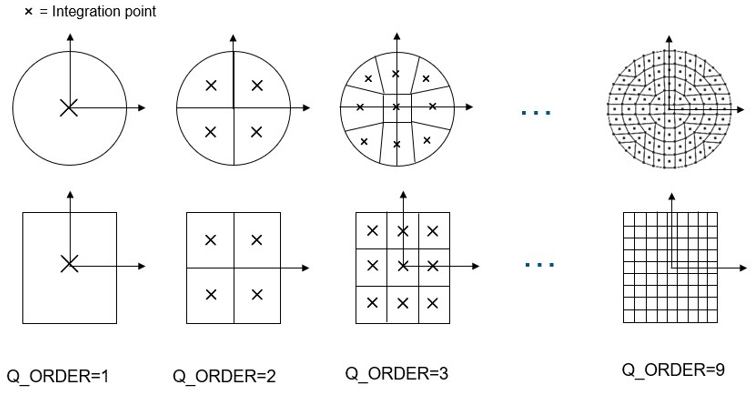
Implicit Analysis: I Section
In implicit analysis, the number of integration point is determined with Q_ORDER and Q_ORDER2. By default it is 2x2, thus 32 integration points.Figure 22. Implicit Analysis I Section Integration Points 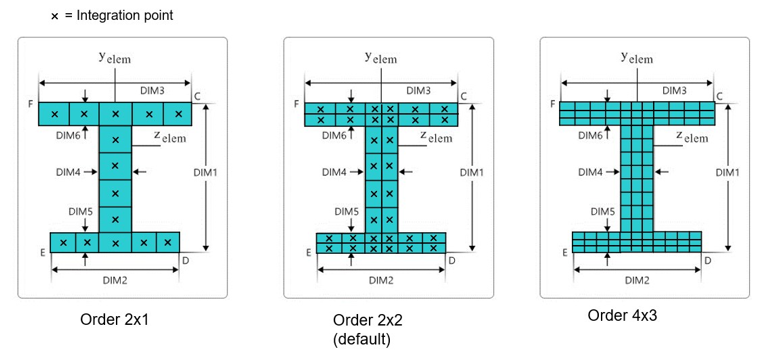
In explicit analysis, some examples of integration point distribution in beam cross sections based on the Q_ORDER value are:
Explicit Analysis: ROD and BAR sections
Figure 23. BAR Section Q_ORDER = 5 (Default) 
Figure 24. BAR Section Q_ORDER = 4 
Figure 25. ROD Section Q_ORDER = 4 (Default) 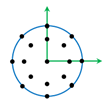
Figure 26. ROD Section Q_ORDER = 5 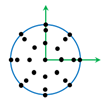
Explicit Analysis: I Section
Sub-section definition is similar to implicit analysis. The default values for Q_ORDER and Q_ORDER2 are also the same as for implicit analysis.Figure 27. I Section Order 2x2 (Default) 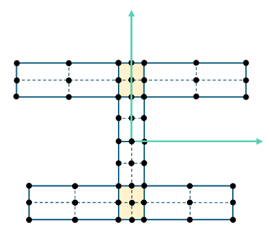
- This card is represented as a property in HyperMesh.



















